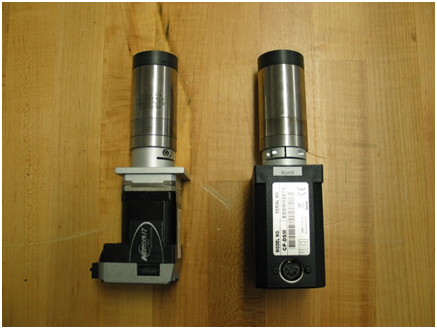Global FIA also made a few forays into the field of medical diagnostics working on a device to measure blood clotting time and one to measure free-bilirubin in pediatric samples. While both efforts resulted in working instruments the challenges of obtaining funding to gain FDA approval and commercialize the instrument have to date proven insurmountable.
A key device in each of Global FIA's instruments is the fluid propulsion device. When Ruzicka and Marshall conceived of SIA they employed a crude syringe pump that was driven by the rotating cylinder of an old peristaltic pump. This soon gave way to syringe pumps with far more elegant linear drives. But these too had their limitations. Wolcott had experimented with a pair of FMI pumps to see if he could get pulseless flow by coordinating the output of two pulsing pumps. These efforts opened the door to an innovative design employing four pistons located in a rotating cylinder driven by a cam that provided a unique synchronization of piston movement. At any one time, one of the pistons is filling, one dispensing, and the other two are moving between the inlet and outlet ports. The cam provides the precise time needed and the rotating cylinder provides the piston switching that eliminates the need for additional valves. Wolcott had described his invention in a lengthy document which he gave to Olson. Olson, discerning a potential winner, shared this document with Marshall in the first week of Marshall being employed at Global FIA. It was immediately obvious to Marshall that this pump had tremendous potential and Olson and Marshall encouraged Wolcott to take the steps necessary to reduce the idea to a working prototype. The first prototype that was developed worked as expected but highlighted the need for more engineering, materials selection to meet the needs of a chemically-inert pump, and a custom-designed pump drive. Olson called on Valco for their engineering and materials selection expertise and Marshall called on Nymotion, a small veteran-owned motion control company, for help in designing the pump drive. Valco's perseverance and world-class expertise were vital in turning Wolcott's initial good idea into a top-class precision pump. Global FIA is constantly surprised to see how the milliGAT has been used in fields other than flow-based analysis. One year when Global FIA exhibited the pump in their booth at Pittcon, an old veteran of the pump business came by and said that the milliGAT was the best innovation in pump technology he had seen in 40 years. That compliment brought more joy than any pump sales at Pittcon. As a pump for flow-based analysis, it has one particular characteristic - after using the milliGAT it is difficult to go back to a syringe pump. Olson recalls Jarda Ruzicka commenting numerous times to him and others over the years that due to the shortcomings of peristaltic and syringe pumps, the greatest hardware need in FIA and SIA was a pump designed specifically to meet the needs of these technologies. Everyone who worked with FIA and SIA knew that he was right. The milliGAT fulfills this need.
milliGAT pump

The APDS project was good for business but dependence on government funding can be a precarious business model. As the APDS project wound down and efforts turned to transitioning the R&D effort into a commercialization effort with Northrop Grumman, Global FIA continued as a supplier to Northrup's APDS effort and began to look for other new markets as well. Two of the most recent identified were the growing environmental market in China and a demand for commercial instruments for Chemical Oceanographers. Several instruments were developed in collaboration with Microfluidica for sale predominantly into the Chinese market. These devices are intended to be used in the event of environmental spills and disasters.









